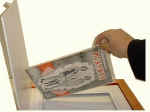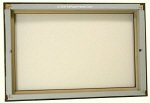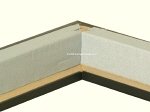What is the Best Conservation Frame?
One of the questions I get asked most often is how to best protect a collectible and what is the best frame for this.
All my framing systems were designed with conservation and protection in mind.
This actually a lengthy subject, but I have two pages that deal with this in more detail.
Please read the pages on
Conservation
and
Encapsulation.
The first page also contains links to Library of Congress pages on conservation.
You will need to understand my Changeable and Value Frames before reading this page.
You can read more about them on my
FAQs page.
The conservation ranking of my frames are shown below ranging from the very best very good. Pricing is variable, with the frames that provide the best conservation costing more.
For all of the Frame Types listed below, conservation isn't complete without using UV or UV/NG acrylic. The description for each type assumes that you have selected UV or UV/NG acrylic. If you select Premium Clear Acrylic (FF3) or non-glare acrylic, the other conservation protections of your frames remain but you lose high (99%) uv protection. Regular and NG acrylic have a provide 66% UV protection
Conservation of Frames Ranked
The conservation ranking of my frames are shown below ranging from the very best very good. Pricing is variable, with the frames that provide the best conservation costing more.
For all of the Frame Types listed below, conservation isn't complete without using UV or UV/NG acrylic. The description for each type assumes that you have selected UV or UV/NG acrylic. If you select Premium Clear Acrylic (FF3) or non-glare acrylic, the other conservation protections of your frames remain but you lose high (99%) uv protection. Regular and NG acrylic have a provide 66% UV protection
The Best Conservation Frame
My Changeable Frames provide the very best protection and conservation for your collectible. Why? Because your collectible is encapsulated in a 4 Mil sleeve. Mylar Sleeves are approved by The Library of Congress for long term care of paper products (hundreds of years). Mylar will not discolor, damage or adhere to items placed inside it. It is a sturdy film that will give extra support to fragile documents. It naturally resistant to aging, decomposition, moisture, oxygen, and gas penetration. It is not affected by fungus, mold, or mildew, and immune to insects and rodent attacks.
If you want the best for your collectible, my Changeable Frames with UV or UV/NG acrylic is your best choice.
Excellent Protection. The Value Frame with Conservation Option
While my Changeable Frames provide the best protection, the cost is higher than my Value Frames. The Value Frame itself provides very good protection but it is increased with the Value Frame Conservation Option. This is the next best option and provides an economical alternative to the Changeable Frame. It is also an option for those that do not want mats on their frame.
In addition to the normal features of the Value Frame described below, the Conservation Option also provides:
- Archival Cotton Rag Backing
- Archival Mylar Sheet placed between the acrylic and the collectible
- Archival Frame Sealing Tape
The Archival foam core backing has a 100% archival cotton rag surface. Its facing paper on each side has a pH of 8.2 +/- .5 and a calcium carbonate buffer. Constructed with pure, naturally white cotton fibers, this Foam Board contains no lignin, alum or harsh chemicals. Cotton Rag provides the highest level of protection for foam core and mat board. Usually Cotton Rag foam core is provided for your frame. For thicker items, I may use thinner Cotton Rag mat board.
The frame sealing tape provides an effective framing barrier for raw wood rabbets. Acid-free, lignin-free buffered paper is laminated to a thin aluminum barrier layer and coated with an aggressive acrylic adhesive that holds strong to raw wood. The layer of aluminum provides a barrier that stops acid migration and meets the standard for maximum preservation framing. The images below show a frame that has been sealed using this tape.
The 4 Mil Mylar sheet provides an archival barrier between the collectible and the acrylic.
The combination of the cotton rag backing, the frame sealing tape and the 4 Mil mylar sheet provide the best encapsulation and protection without using a Mylar Sleeve.
I am sometimes asked whether a Mylar Sleeve can be used with a Value Frame. Simply put; No. Out of necessity, a Mular sleeve needs to be somewhat larger than the collectible. I would need to size the Value Frame to fit the sleeve, not the collectible. The sleeve needs to be a size appropriate for the collectible. If you choose one that is too narrow, the collectible won't lie flat, especially for collectibles 1/8" or more thick. Typically the sleeve must be at least 1" wider than the collectible. A typical 8" x 10 1/2" magazine uses a sleeve of 9" x 11 1/2". Framing such a magazine and sleeve would show gaps when placed in the frame as the frame would be larger than the frame.
Very Good Protection. The Value Frame
The basic Value Frame when combined with UV or UV/NG acrylic provides very good protection for your collectible. The foam core backing is acid free with a chemically inert core. The surface sheet on both sides of the board has a pH of 7.3 - 8.5 and is buffered to maintain its pH level.
The collectible will be sandwiched between the backing and the acrylic. The acrylic, being a plastic, has very different thermal properties from glass. If I used glass I would need to provide an archival spacer to prevent sticking. Since acrylic is closer to Mylar than glass, a spacer is not needed unless the collectible is in a very humid environment. I have provided thousands of Value Frames since 2001 and never had a report of a collectible sticking to the acrylic.




